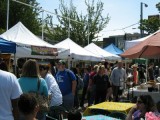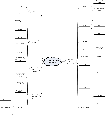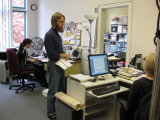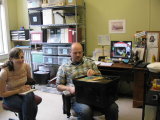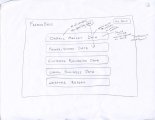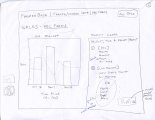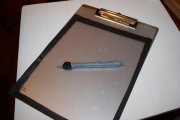In collaboration with G Chang, R M Hogsett, R Hungerford, and N Sweers.

Goal: Design a mobile device for the year 2020
For our target user population we began by focusing on some aspect of farmers markets, a growing phenomenon in Seattle and a challenging area for technological solutions.
Stage 1: Observation
We commenced with research of farmers markets in the region, coupled with observations of local markets where we interviewed farmers and organizers. After comparing notes and discussing aspects of farmers markets, we narrowed our focus to the market organizers. We concluded that were we to focus on farmers, we would merely be designing for the future application of today’s technology, and it is the organizers who have larger data management needs.
Two organizations in Seattle managed farmers markets of one sort or another. We focused our observations on theNeighborhood Farmers Market Alliance, whose markets focused exclusively on farm products (vs. on crafts). Three of us conducted a contextual inquiry at the NFMA’s office.
To our surprise, we descovered that data at markets was collected with pen, clipboard, and paper forms, stored in file boxes, and manually entered in Excel spreadsheets. Funding came from farmers’ sales and grants. As organizers, their self-perceived gratest challenges were twofold (1) Securing and financing the physical space for each market, and (2) Outreach and education to new shoppers (health and budget) and local businesses (benefits of the market’s presence).
Stage 2: Ideation
Our group worked through several phases of ideation, focusing in turn on the state of society in 2020, the development of technology, and potential design metaphors, for which we applied structured brainstorming and affinity diagramming. We visualized that the Future would contain a shift towards renewable energy and strengthening of the green movement, an increase in public transit ridership, and the reclimation of shopping districts for pedestrian use. The march of technological progress will lead to ubiquitous wireless in cities, social networking as the pervasive medium for event broadcasting, the exclusive use of credit cards, and cheap wireless monitors. Technology that will be available in a handful of years will be commonly affordable in a dozen.
For the market organizers’ problems which remained unsolved by the future, namely paper and spreadsheets and newsletters, we conceived of a portable device utilizing the familiar pen and clipboard metaphor. As computers miniaturize and monitors go wireless, something the size of a pen will replace the PDA and transmit to any nearby monitor of choice. Using the stylus to interact with any screen, information can be gathered, managed, and broadcast on a device which goes back in your shirt pocket without having to worry about the screen. The future MacBook Air.
Stage 3: Rapid prototyping & evaluation
Our prototyping phase focused primarily on the interface for our device. Our emphasis in design was to keep our scope appropriately restricted to the needs of a farmers market organizer. Over a couple iterations we narrowed down the primary menu choices to “Market” and “Network” in addition to what would be standard Settings and Programs options. Visually we went with a circular menu to fit the use of a stylus-focused monitor. Similarly, for the pen itself we focused on parity of design, settling on two buttons and a streamlined contour.
Our paper prototypes we tested with organizers at the farmers market, as well as with other non-market users for general heuristics feedback. In addition we devised a persona , Fran the organizer, to aid us in our design reflections.
End result: The P.I.M.P.
Presenting, for lack of a better marketing department, the Personal Information Management Pen. The P.I.M.P. offers farmers market organizers a familiar pen-and-clipboard metaphor, yet functions in an intuitive point/write fashion. The pen wirelessly gathers opt-in sales data from farmers stalls as the market organizer makes the rounds of the market, and the clipboard interface allows direct editing or manual input of information. Connected to the city wireless network, the pen’s Market application can be set to automatically broadcast aggregate data about produce information. Finally, for more detailed manual data entry, the P.I.M.P. can be taken back to the office to dock in a keyboard’s inkwell to utilize the enduring speed of typing.
Check out a demo of the interface, or pretend you have a stylus and try it yourself (pdf).
